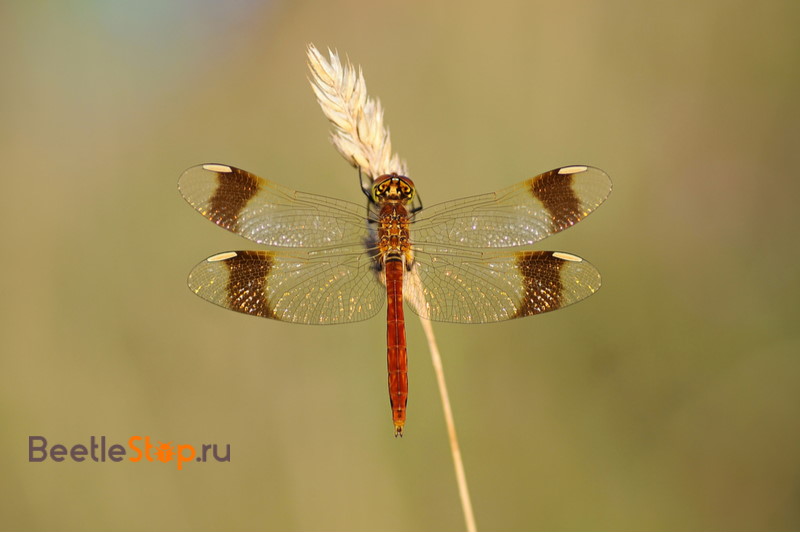Bandaged dragonfly: one of the gifts of nature that requires protection
Representatives of the family of real dragonflies can be found everywhere except Antartida. Some of the oldest amphibious insects have more than 1000 species. Active predators with four transparent wings settle on the banks of water bodies. flying insects need water to grow offspring. Tied up dragonfly and other species place their eggs in water bodies where larvae develop. Pollution of lakes and ponds significantly reduces the dragonfly population. In Europe, the species Sympetrum pedemontanum fell into the IUCN Red List.
Morphological description of the species
Bandaged dragonfly (Sympetrum pedemontanum) is a representative of the dragonfly squad, genus Squint. The second name of the species is the piedmont squeezed bellfish, associated with the preferred habitats of the insect. Body length 28-36 mm, of which 18-23 mm fall on the abdomen. The wingspan of males is 54-56 mm, females 44-46 mm. The head is large, free, wider than the chest and abdomen. Thanks to its flexible joint, it can rotate 180 °. The eyes are complex, hemispherical in shape.

The chest is strong, muscular, each part of it carries one pair of limbs. The posterior margin ends with a vertical protrusion covered with long hairs. The chest of the male is brownish-red, the females are gray-brown. Outside, the body is covered with a layer of chitin, forming an external skeleton. The wings are transparent with a thick and complex venation. A characteristic feature of the species is a dark transverse band at the edge of the wings. The intensity of its color varies from beige to red. Color depends on the age and gender of the insect. Pterostigma (thickening of the anterior margin of the wing) in males is bright red, in females it is yellowish.
Information. Amphibiotic insects are characterized by development in the aquatic and air environment. At the stage of eggs and larvae, they live in water; at the age of adults, they live on land.
Like other representatives of the genus, the abdomen of a bandaged dragonfly is long and flattened. Consists of 10 segments formed by chitinous guards. On the last segment are anal appendages. Males have genital hooks with which they hold their partner during mating. The limbs consist of 5 parts, on the legs there are two rows of spines. The legs are completely black.
Distribution area
Species Sympetrum pedemontanum refers to tranpalearctic. Dragonflies live in Central and Southern Europe, in the temperate regions of Central Asia, Turkey, Mongolia, China, Korea and Japan. In Russia, the distribution area includes Crimea, southern Siberia, Primorye and Sakhalin. Insects are found in the Carpathian and Transcarpathian regions at an altitude of up to 500 m. In habitats, populations are limited to single individuals. The species has completely disappeared in Luxembourg, appears periodically in Denmark and the UK.
Lifestyle
Dragonflies settle near low-flowing or standing freshwater bodies. Adult years are observed from June to September. The flight is weak, adults try to stay closer to the vegetation. Predators on the fly catch and eat small insects: midges, mosquitoes, flies and other dipterans. During the mating season, the males of the tied dragonfly demonstrate territorial behavior, driving away strangers.
Offspring development
After fertilization, the female lays eggs in water during a low flight or while sitting on an aquatic plant.Fertility of the insect is up to 500 eggs. Dragonflies are insects with incomplete transformation. From eggs in the water, larvae appear, called naiads or nymphs. The appearance and structure of the body, they are significantly different from adults. Predatory mollusks do not move very much; mosquitoes, tadpoles, and worms are caught from an ambush. Their body is wide and flat. A large head is fused to the body. To grab prey, the larvae have a special apparatus - a mask.
The development of nymphs takes 1 year, during which time they molt 7-8 times. An adult larva emerges from the water onto a plant, stone or branch. Skin dried in the air bursts, an adult dragonfly appears from it. It takes her several hours to get the color that matches the look.
Protection and limiting factors
The tied dragonfly entered the European Red List as a threatened species. Pollution and destruction of the insect habitat leads to a decrease in population. In some regions of Europe, dragonflies die when draining drainage channels and artificial ponds. Coastal areas and reservoirs of Russia are exposed to anthropogenic load. Sympetrum pedemontanum species requires protection in Voronezh, Belgorod, Lipetsk, Saratov and other adjacent areas. Insects are recorded in the regional Red Book as a rare species.

